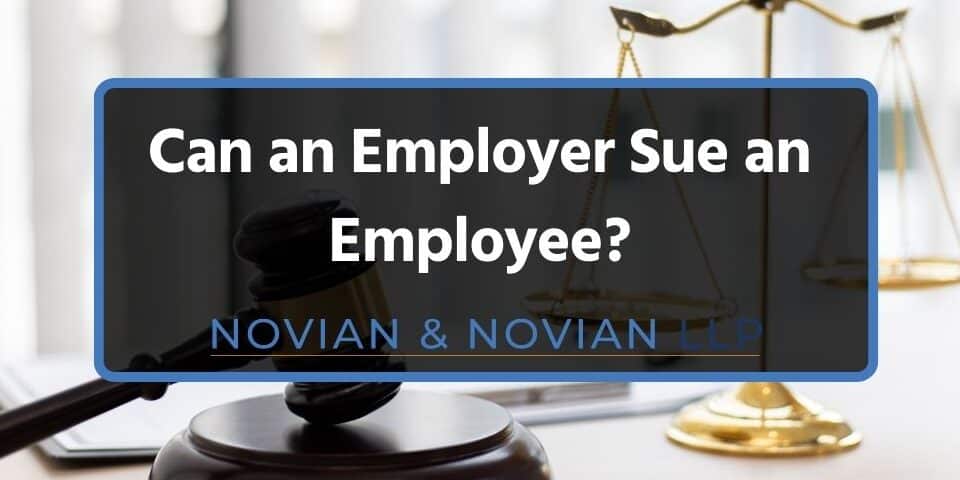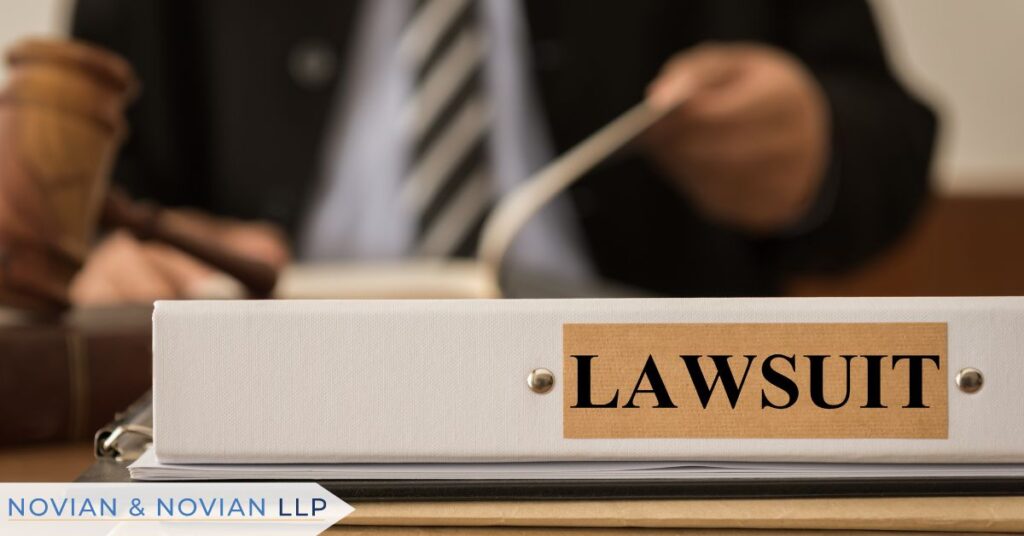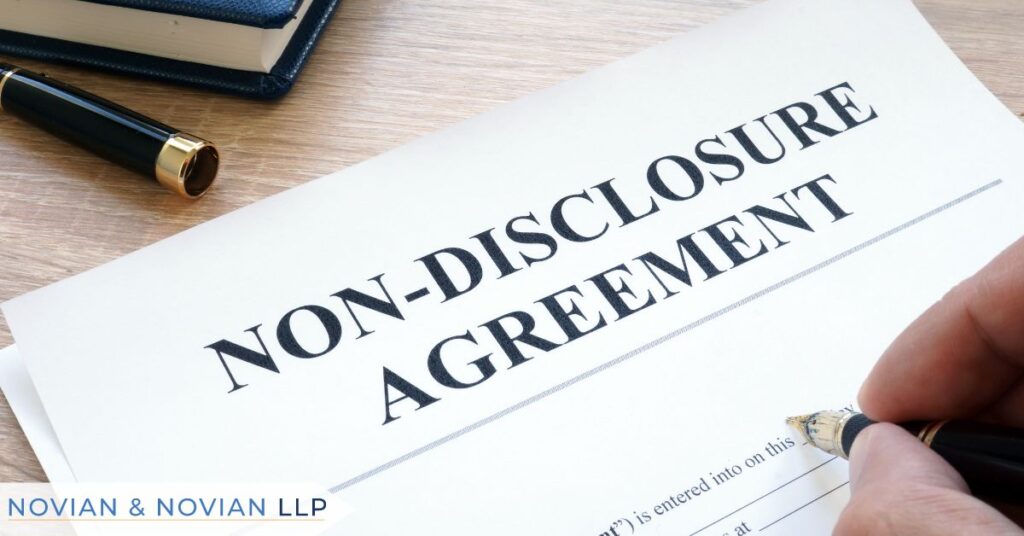
by | Jan 22, 2024 | Employment Law
Employer-employee legal dynamics refer to the complex set of legal relationships and obligations between employers and employees in the workplace. These dynamics are governed by employment laws and regulations that vary across jurisdictions.
An employment contract binds both employers and employees. Breach of contract by either party can be grounds for legal action.
At Novian & Novian, we provide expert legal advice on the intricacies of the employer-employee legal dynamics, helping you understand your rights and obligations. With over 35 years of industry experience, a deep understanding of the law. We build and maintain trustworthy relationships with our cand lients, contact us if you need dependable legal counsel!
In this article, we will explore the circumstances under which an employer can legally sue an employee.
Grounds for an Employer to Sue an Employee
Although it is more common for an employee to file a lawsuit against an employer, there are many circumstances where an employer would sue an employee.
This may include employee theft, disclosing a trade secret, breach of contract, defamation, embezzlement or fraud, intellectual property infringement, violation of non-solicitation agreements, breach of fiduciary duty, and tortious interference.
Ultimately, an employer can sue an employee if the employee’s actions have caused harm to the company.
Breach of Contract
A breach of contract in the employment context occurs when one party, either the employer or the employee, fails to fulfill the terms and obligations specified in their employment agreement or contract. Employment contracts can be written or implied and typically outline various aspects of the employment relationship, including job responsibilities, compensation, duration of employment, and conditions for termination.
An employee may be in breach of their contract due to non-performance of the duties outlined in their job description or employment contract, breach of confidentiality, violation of the code of conduct, unauthorized disclosure of trade secrets, or failure to meet performance targets.
Theft or Fraud
Theft in the workplace refers to an employee unlawfully taking an employer’s property or assets without authorization or consent.
On the other hand, fraud is the intentional deception or misrepresentation by an employee for unlawful gains at the expense of a business.
Disclosure of Confidential Information
An employer’s confidential information includes sensitive and proprietary data that is not publicly available to anyone who is not a current or former employee.
If an employee discloses confidential information covered by a non-disclosure agreement, the employer may sue for damages resulting from the breach.
Non-Compliance with Non-Compete Clauses
An employment contract usually contains non-compete clauses that restrict employees from engaging in a competitive activity. For example, this may include working for a new employer, who is a competitor, or starting a competing business for a specific period and within a defined geographic area.
There are certain circumstances where non-compliance could lead to a lawsuit. This may involve using proprietary information for new employment, attempting to ruin an employer’s reputation, or immediately joining a competing company.
If an employee violates the terms outlined in an agreement, they may be held liable if an employer takes legal action.
Employers may seek legal remedies such as injunctions to prevent further violations, as well as damages for any harm suffered due to the breach of the non-compete agreement. The success of such lawsuits depends on the specific terms of the non-compete clause and the applicable laws in the jurisdiction.
The Legal Framework
The relationship between employers and employees is governed by a complex web of legal principles and regulations, collectively known as employment law. This legal framework is designed to balance the rights and responsibilities of both parties, ensuring a fair and just workplace. Understanding these principles is crucial, especially when considering the context of lawsuits between employers and employees.
Key aspects of employer-employee legal dynamics include employment contracts, workplace discrimination and harassment laws, wage and hour regulations, workplace safety, and termination procedures.
Employment law comprises a range of statutes, regulations, and case law that regulate the rights and duties between employers and employees. The primary objectives of employment law include protection of workers, regulation of employment terms, health and safety, equality and non-discrimination, etc.
An employment contract binds both employers and employees. It could be written, oral, or implied. The contract sets out the terms and conditions of employment, and both parties are legally obligated to adhere to these terms. Breach of contract by either party can be grounds for legal action.
Employees have various rights under employment law, such as the right to fair compensation, safe working conditions, and freedom from discrimination. Conversely, employers have corresponding obligations. Failure to fulfill these obligations can lead to legal disputes.
Understanding employment law is critical when it comes to lawsuits in the workplace.
For employers, it’s about ensuring compliance with legal standards to avoid litigation. For employees, it’s about knowing their rights and when they can legally challenge their employer’s actions.
Legal Process and Considerations
Now that we understand the question ”Can an employer sue an employee?” we must also understand the legal steps a employer has to take to sue an employee.
Firstly, the employer must identify a legal basis for the lawsuit, such as breach of contract, theft of intellectual property, or violation of non-compete agreements. The employer should then engage in dispute resolution procedures, such as negotiations or mediation, before resorting to litigation. If a resolution is not achieved, the employer can initiate a lawsuit by filing a complaint in the appropriate court.
An employer generally bears the responsibility to demonstrate the employee’s wrongdoing. This involves presenting evidence that supports the legal claims made in the complaint. Evidence may include relevant documents, such as employment contracts, emails, or financial records, as well as witness testimonies. The burden of proof is typically on the employer to show, by a preponderance of the evidence, that the employee’s actions violated the law or the terms of their employment contract.
At Novian & Novian, we are here to act in your best interest as an employer. We will work with you and simplify the process of suing an employee. Our goal is to ensure that you have a smooth legal process and get the justice you deserve.
Alternatives to Lawsuits
Alternatives to filing lawsuits to recover damages include mediation and arbitration.
Mediation is where parties voluntarily agree to mediate any claims with a mediator who facilitates discussions to help them find a solution.
Arbitration involves an arbitrator reviewing any evidence presented by both parties, listening to arguments, and rendering a decision based on the dispute. In binding arbitration, the decision is final and enforceable in court. Non-binding arbitration allows parties to pursue litigation if dissatisfied with the arbitrator’s decision.
Lawsuits can result in a large monetary loss, so mediation and arbitration offer cost-effective and faster resolutions. A drawback is the lack of a formal judicial process to litigate complex legal matters and the lack of enforceability in non-binding arbitration.
Internal Resolution Mechanisms
Resolving disputes internally within a company is often the most efficient and least disruptive approach. Companies typically establish internal resolution mechanisms as part of their human resource policies to handle conflicts effectively. These mechanisms are designed to address issues before they escalate to legal disputes.
Having an open-door policy encourages employees to openly discuss their concerns with their supervisors or HR representatives without fear of retaliation. This approach fosters a transparent and communicative workplace culture. It also allows for early detection and resolution of issues.
Mediation
Mediation is another internal resolution mechanism. It involves a neutral third party who facilitates a discussion between the conflicting parties to help them reach a mutually agreeable solution. This method is particularly effective for interpersonal conflicts, as it allows for a structured yet flexible dialogue.
Companies often provide training to employees and managers on conflict resolution skills. This includes communication techniques, empathy, and negotiation. Equipping employees with conflict resolution skills can prevent many disputes from escalating, promoting a more harmonious workplace.
Some companies establish panels of employees to hear and resolve disputes. These panels usually comprise employees from various departments. Peer review panels can be effective as they bring diverse perspectives to the issue and can foster a sense of fairness and impartiality.
Are you Planning to Sue an Employee?
In this blog, we’ve explored various facets of employer-employee relationships, focusing on the legal rights and mechanisms for resolving disputes. We delved into situations where employers can sue employees and discussed the legal framework governing these relationships. Additionally, we examined effective internal resolution strategies that companies can implement to manage conflicts.
Employers must navigate the relationship with their employees with care.
At Novian & Novian, we are experts in employment law. Our goal is to help clients maintain legal compliance while fostering a healthy workplace culture.
Reach out to Novian & Novian today to schedule a consultation and take the first step towards addressing your concerns.
Contact Us
Have questions about this post? Novian & Novian is a full service law firm in Los Angeles with clients that span the country. Contact us today for a free consultation.
Contact Us
Have questions about this post? Novian & Novian is a full service law firm in Los Angeles with clients that span the country. Contact us today for a free consultation.




